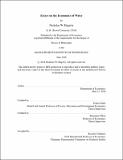Essays on the economics of water
Author(s)
Hagerty, Nicholas W. (Nicholas William)
DownloadFull printable version (2.767Mb)
Other Contributors
Massachusetts Institute of Technology. Department of Economics.
Advisor
Esther Duflo and Benjamin Olken.
Terms of use
Metadata
Show full item recordAbstract
This thesis studies three questions in the economics of water resource management. Chapter 1 estimates the economic gains available from greater use of large-scale water markets in California. I develop a revealed-preference empirical approach that exploits observed choices in the existing water market, and I apply it to comprehensive new data on California's water economy. This approach overcomes the challenge posed by transaction costs, which insert an unobservable wedge between observed prices and marginal valuations. First, I directly estimate transaction costs and use them to recover equilibrium marginal valuations. Then, I use supply shocks to estimate price elasticities of demand, which govern how marginal valuations vary with quantity. I find even a relatively modest market scenario would create additional benefits of $480 million per year, which can be weighed against both the benefits of existing market restrictions and the setup costs of larger-scale markets. Chapter 2 estimates the possible costs of industrial water pollution to agriculture in India, focusing on 63 industrial sites identified by the central government as "severely polluted." I exploit the spatial discontinuity in pollution concentrations that these sites generate along a river. First, I show that these sites do in fact coincide with a large, discontinuous rise in pollutant concentrations in the nearest river. Then, I find some evidence that agricultural revenues may be substantially lower in districts immediately downstream of polluting sites, relative to districts immediately upstream of the same site in the same year. These results suggest that damages to agriculture could represent a major cost of water pollution. Chapter 3, co-authored with Ariel Zucker, presents an experimental protocol for a project that pays smallholder farmers in India to reduce their consumption of groundwater. This project will test the effectiveness of payments for voluntary conservation - a policy instrument that may be able to sidestep regulatory constraints common in developing countries. It will also measure the price response of demand for groundwater in irrigated agriculture, a key input to many possible reforms. Evidence from a pilot suggests that the program may have reduced groundwater pumping by a large amount, though confidence intervals are wide.
Description
Thesis: Ph. D., Massachusetts Institute of Technology, Department of Economics, 2018. This electronic version was submitted by the student author. The certified thesis is available in the Institute Archives and Special Collections. Cataloged student-submitted from PDF version of thesis. Includes bibliographical references (pages 159-165).
Date issued
2018Department
Massachusetts Institute of Technology. Department of EconomicsPublisher
Massachusetts Institute of Technology
Keywords
Economics.